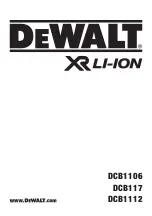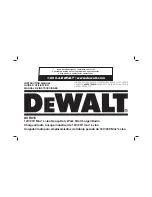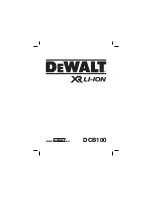
Eng
lish
8
9
!
DANGER!
Damaged batteries need a special packaging for shipping because they are very
toxic!!!!!
Environmental information
DISPOSAL INSTRUCTION
This symbol on the product, user manual or packaging indicates that this product must
not be disposed of with other household waste at the end of its life. It must be handed
over to the applicable collection point for the recycling of electrical and electronic equip-
ment.
The materials are recyclable as marked. By material recycling or other forms of re-usage you are
making an important contribution to environmental protection.
Batteries and accumulators must be removed from the device and disposed of at an appropriate
collection point.
Please inquire if necessary from the local authority for the appropriate disposal site.
General operating information
• When charging the battery it is supplied a certain amount of electricity, which results from multi-
plying charge current by charge time. The maximum amount of power depends on the capacity
of each battery and the maximum charge current according to the battery type. Both values are
given in the specifications of the battery manufacturer.
Only when explicitly rated, fast rechargeable batteries can exceed the normal charging
rate. As STANDARD CHARGE CURRENT, is referred to the 1/10 of nominal capacity: (1/10
C) for a battery with a capacity of 1700 mAh the standard charge current is 170 mA.
• The battery should be connected using a suitable charger cable to the connection terminals of
the charger (red = positive, black = negative). Use only original charging cable with sufficient
cross-section.
• Always follow and observe the recommended charge currents and charge times as rated in the
instructions of the battery manufacturer. Only batteries which are expressly suitable for quick
charge can be charged with the high charging currents provided by this charger.
• Please keep in mind that new batteries reach their full capacity after several charge / discharge
cycles. Some new or deep discharged batteries may also have premature charge termination.
• Should, after a fast charge, a cell of the NiXX battery packs have become particularly hot, this
may indicate a defect of that cell. This battery pack should no longer be used! (Used batteries
have to be disposed of as special waste!).
• Since the charger can only detect the total resistance, but does not distinguish between internal
resistance of the battery, cable resistance and connector transfer resistance, the first require
-
ment for a proper function is a charging cable with sufficient cross-section and a length of not
more than 30 cm with high performance connectors (gold contacts).
•
A transmitter built-in battery can be charged via the fitted charge socket.
• Transmitters are often included with a reverse current protection in the form of a diode. This pre-
vents damage for the transmitter from reverse polarity and short circuit between the bare ends
of the charging cable connector. Depending on the design of this diode CAN however even
hinder a correct recognition of the state of charge by the automatic charger.
• The maximum allowable charge current for the transmitter must never be exceeded.
• To prevent internal damage to the transmitter due to overheating due to a fast charge, the trans-
mitter battery should be removed from the transmitter battery compartment.
• The transmitter MUST be switched „OFF“ (OFF) during the charging process!
• Never turn on the transmitter when it is connected to the battery charger.
• Do not discharge the battery through maintenance programs via the charge socket!
Summary of Contents for POLARON EX-1400
Page 52: ...English 52 ...









































